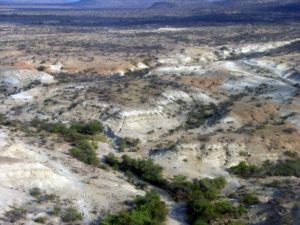
Analysis of a 139-meter long drill core taken from a site in the Koora basin, Kenya, shows an environmental record of the past 1 million years in the East African Rift Valley, indicating an ancient fluctuation of the climate, landscape and ecosystem that precipitated a major transitional period in the course of human evolution in the region.
Richard Potts, director of the Human Origins Program at the Smithsonian’s National Museum of Natural History, along with a research team and collaborators from the National Museums of Kenya, have been conducting investigations and excavations in the Olorgesailie Basin, Kenya, for decades. Here, they have uncovered artifacts and other evidence of a hominin (human and human biological ancestor) presence spanning more than 1 million years. Olorgesailie is perhaps best known for its numerous Acheulean stone handaxes—a stone tool type produced by hominins and typically associated with the Homo erectus species. The form and prevalence of these artifacts remained remarkably consistent in the area for about 700,000 years. Beginning in 2002, Potts and colleagues from the Smithsonian Institution, the George Washington University and the National Museums of Kenya began encountering artifacts that differed markedly from the Acheulean. Dated to as early as 320,000 years ago, they were smaller, more elaborate, and included projectiles. Many of them were made from materials that had to be acquired from relatively distant locations. Coloring materials were also uncovered. These discoveries suggested a different behavioral lifestyle and more advanced technology. Classified as Middle Stone Age materials, it seemed clear that a very different kind of hominin created them. The findings suggested an evolutionary transition had occurred.
In their effort to investigate more about this transition, however, Potts and his team were stymied by the discovery of a significant 180,000-year ‘gap’ in the environmental history, created by the geological erosion of layers corresponding to this time period. The ‘gap’ would have represented a record of the evolutionary transition. This led them to seek elsewhere for this missing time period.
Moving to a different location about 15 miles from their Olorgesailie excavations at Koora basin, they obtained services from a Nairobi company to drill a 139-meter core into the surface, obtaining a record of 1 million years of environmental history. Their subsequent analysis revealed a history of tectonic activity and ecological changes that showed the environment began to become much more variable at around 400,000 years ago, presenting new survival challenges to the animals, including the hominins, in the region. The changes coincided with the transitional period that featured the Middle Stone Age artifacts.
Pots and his team found the missing gap, and combined with analysis of the archaeological and fossil record in the area, they were able to reconstruct a time when early hominin adaptability to change, an important hallmark of humans, and particularly Home sapiens—the lone survivor of the genus Homo—opens a window on human evolution.
More detail can be read in the Oct. 21, 2020 issue of the journal Science Advances and the subject Smithsonian news release.
__________________________________________
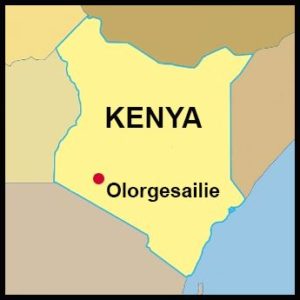
Map of Kenya, showing location of Olorgesailie. Human Origins Program, Smithsonian
__________________________________________

Aerial photo of Olorgesailie. Human Origins Program, Smithsonian
_________________________________
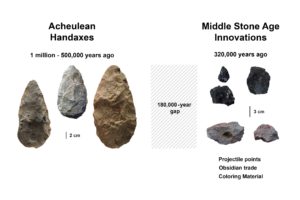
Olorgesailie Acheulean handaxes compared to Olorgesailie MSA points and pigments. Potts and colleagues documented a major behavioral and cultural shift among humans in 2018 based on artifacts recovered at the Olorgesailie archaeological site in modern day Kenya. Decades of study at Olorgesailie by Potts’ team and collaborators at the National Museums of Kenya have determined that early humans at Olorgesailie relied on the same tools, stone handaxes, for 700,000 years. Then, beginning around 320,000 years ago, people living there entered the Middle Stone Age, crafting smaller, more sophisticated weapons, including projectiles. At the same time, they began to trade resources with distant groups and to use coloring materials, suggesting symbolic communication. Human Origins Program, Smithsonian
_________________________________
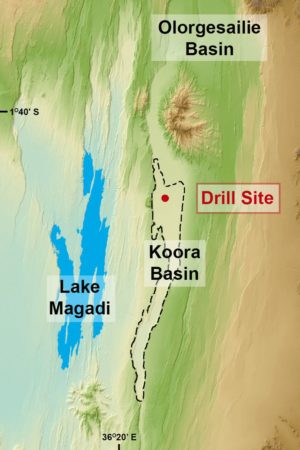
Topographic map of the drill site based on the TanDEM X Science DEM (DLR 2017). Courtesy of R. Dommain, University of Potsdam. Human Origins Program, Smithsonian
_________________________________
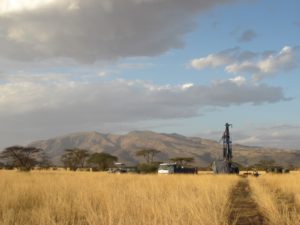
View of the drill site, with apparatus in place. Human Origins Program, Smithsonian
_________________________________
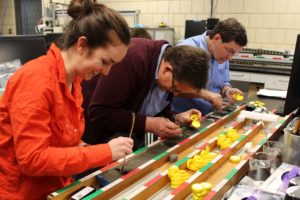
The LaCore Workshop. Drill cores were shipped to the National Lacustrine Core Facility (La Core) at the University of Minnesota. Colleagues in the National Museum of Natural History’s Human Origins Program and Department of Paleobiology and dozens of collaborators at institutions worldwide worked to analyze the environmental record they had obtained, which is now the most precisely dated African environmental record of the past 1 million years. Charting radioisotope ages and changes in chemical composition and deposits left by plants and microscopic organisms through the different layers of the core, the team reconstructed key features of the ancient landscape and climate across time.
They found that after a long period of stability, the environment in this part of Africa became more variable around 400,000 years ago, when tectonic activity fragmented the landscape. By integrating information from the drill core with knowledge gleaned from fossils and archaeological artifacts, they determined that the entire ecosystem evolved in response. Human Origins Program, Smithsonian
_________________________________
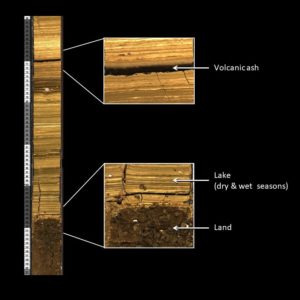
Drill Core detail. The team’s analysis suggests that as parts of the grassy plains in the region were fragmented along fault lines due to tectonic activity, small basins formed. These areas were more sensitive to changes in rainfall than the larger lake basins that had been there before. Elevated terrain also allowed water runoff from high ground to contribute to the formation and drying out of lakes. These changes occurred during a period when precipitation had become more variable, leading to frequent and dramatic fluctuations in water supply.
With the fluctuations, a broader set of ecological changes took place. The team found that vegetation in the region also changed repeatedly, shifting between grassy plains and wooded areas. Meanwhile, large grazing herbivores, which no longer had large tracts of land to feed on, began to die out and were replaced by smaller mammals with more diverse diets.
The findings suggest that instability in their surrounding climate, land and ecosystem was a key driver in the development of new traits and behaviors underpinning human adaptability. Human Origins Program, Smithsonian; Core image courtesy of LaCore, University of Minnesota
_________________________________
See also Olorgesailie, a free premium article published in the summer 2018 issue of Popular Archaeology Magazine.
_________________________________
Advertisement





